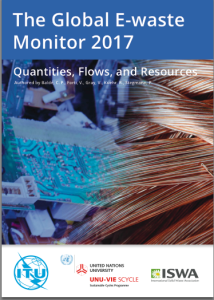 It is our pleasure to present to you the 2017 Global E-waste Monitor, a joint effort of the United Nations University (UNU), the International Telecommunication Union (ITU), and the International Solid Waste Association (ISWA) to increase awareness and draw attention to the growing issue of electronic-waste.
It is our pleasure to present to you the 2017 Global E-waste Monitor, a joint effort of the United Nations University (UNU), the International Telecommunication Union (ITU), and the International Solid Waste Association (ISWA) to increase awareness and draw attention to the growing issue of electronic-waste.
More and more people are joining the global information society and digital economy, and are benefiting from the opportunities they offer. More and faster networks, and new applications and services delivered at increasingly high speeds, have brought new opportunities to many people, particularly in the areas of health, education, government, entertainment, and commerce. In parallel, higher levels of disposable incomes, urbanization, and industrialization in many developing countries are leading to growing amounts of electrical and electronic equipment and, consequently, to greater amounts of e-waste.
Discarded equipment, such as phones, laptops, fridges, sensors, and TVs contain substances that pose considerable environmental and health risks, especially if treated inadequately. Most e-waste is not properly documented and not treated through appropriate recycling chains and methods. At the same time, e-waste streams challenge the efforts towards a circular economy as valuable and scarce resources are wasted. This report represents an important step to identify current challenges and solutions.
Indeed, this report shows that the amounts of e-waste continue to grow, while too little is recycled. By 2016, the world generated 44.7 million metric tonnes (Mt) of e-waste and only 20% was recycled through appropriate channels. Although 66% of the world’s population is covered by e-waste legislation, more efforts must be made to enforce, implement, and encourage more countries to develop e-waste policies.
The report also highlights the lack of reliable e-waste data at the country level. Often, merely anecdotal evidence is available on the production, management, and recycling of e-waste, and only 41 countries in the world collect international statistics on e-waste.
See the document Global-E-waste Monitor 2017
